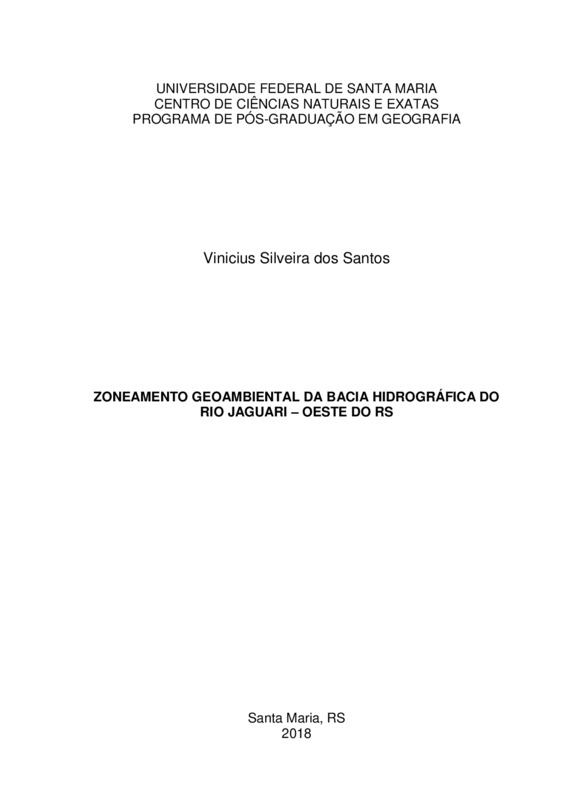-
Título
-
ZONEAMENTO GEOAMBIENTAL DA BACIA HIDROGRÁFICA DO RIO JAGUARI - OESTE DO RS
-
lista de autores
-
VINICIUS SILVEIRA DOS SANTOS
-
Resumo
-
No passar dos anos, e o crescente uso dos recursos naturais pela sociedade, faz-se necessário estudos que possam contribuir no planejamento ambiental adequado, para que a natureza não seja impactada de modo agressivo. Assim, são necessários estudos que possam viabilizar a utilização dos recursos naturais pelo ser humano de modo organizado, para que não impeça a dinâmica de evolução do relevo, e que a ação antrópica não seja determinante na degradação do ambiente. No processo de desenvolvimento dos estudos ambientais, as bacias hidrográficas começam a ser a unidade territorial de análise que melhor representa esses tipos de estudo. O zoneamento geoambiental pode ser caracterizado como um instrumento de auxilio no planejamento e ordenamento territorial, em escala local ou regional. O presente trabalho traz como objetivo geral realizar o zoneamento geoambiental da Bacia Hidrográfica do Rio Jaguari, localizada no oeste do Rio Grande do Sul, com intuito de fornecer informações referentes as aptidões e restrições de uso, ou seja, definir as potencialidades e fragilidades na área de estudo. A revisão bibliográfica apresenta as questões voltadas a Importância da Abordagem Sistêmica nos Estudos Ambientais, a Bacia Hidrográfica como unidade de planejamento e gestão, o Uso da Cartografia Geoambiental e das Geotecnologias nos Estudos Geoambientais e por fim o Zoneamento Geoambiental como uma contribuição ao planejamento ambiental. A metodologia tem como base a análise dos parâmetros físicos do relevo, litologias, tipos de solos e o uso e ocupação da terra, o pós-processamento dos dados envolvidos para a elaboração do zoneamento geoambiental. Para isso, em um primeiro momento, apresentou-se alguns resultados referentes aos elementos físicos do relevo, dando ênfase para a rede de drenagem e parâmetros do relevo. Em um segundo momento, analisou-se os demais parâmetros, como a litologia, solos, compartimentação geomorfológica e análise do uso e ocupação da terra. Por fim, definiu-se os quatro Sistemas Geoambientais e as setes Unidades Geoambientais, que contribuíram no Zoneamento Geoambiental da Bacia Hidrográfica Rio Jaguari.
-
Abstract
-
Over the years, and the growing use of natural resources by society, studies are needed that can contribute to the proper environmental planning, so that nature is not impacted aggressively. Thus, studies are needed that can make the use of natural resources possible by the human being in an organized way, so that it does not impede the dynamics of evolution of the relief, and that the anthropic action is not decisive in the degradation of the environment. In the process of developing environmental studies, river basins begin to be the territorial unit of analysis that best represents these types of studies. Geoenvironmental zoning can be characterized as an instrument of assistance in planning and territorial planning, at a local or regional scale. The main objective of this work is to carry out the geoenvironmental zoning of the Jaguari River Basin, located in the west of Rio Grande do Sul, in order to provide information on the skills and restrictions of use, that is, to define potentialities and fragilities in the area of study. The bibliographic review presents the questions regarding the Importance of the Systemic Approach in Environmental Studies, the Hydrographic Basin as a unit of planning and management, the Use of Geoenvironmental Cartography and Geotechnology in Geoenvironmental Studies and, finally, Geoenvironmental Zoning as a contribution to environmental planning. The methodology is based on the analysis of the physical parameters of the relief, lithologies, soil types and land use and occupation, the post-processing of the data involved for the elaboration of geoenvironmental zoning. For this, at first, some results were presented referring to the physical elements of the relief, giving emphasis to the drainage network and relief parameters. In a second moment, the other parameters, such as lithology, soils, geomorphological compartmentalization and land use and occupation analysis were analyzed. Finally, the four Geoenvironmental Systems and the seven Geoenvironmental Units were defined, which contributed to the Geoenvironmental Zoning of the Jaguari River Basin.
-
Palavras Chave
-
ESTUDOS AMBIENTAIS
-
BACIA HIDROGRÁFICA
-
CARTOGRAFIA GEOAMBIENTAL
-
ZONEAMENTO GEOAMBIENTAL
-
POTENCIALIDADES
-
FRAGILIDADES
-
Key Words
-
ENVIRONMENTAL STUDIES
-
HYDROGRAPHIC BASIN
-
GEOENVIRONMENTAL CARTOGRAPHY
-
GEOENVIRONMENTAL ZONING
-
POTENTIALS
-
FRAGILITIES
-
Tipo
-
MESTRADO
-
Universidade
-
UNIVERSIDADE FEDERAL DE SANTA MARIA
-
Data
-
2018
-
Páginas
-
177
-
Localização
-
Biblioteca Digital de Teses e Dissertações (BDTD UFSM)
-
Orientador
-
LUIS EDUARDO DE SOUZA ROBAINA
-
Programa
-
Programa de Pós-Graduação em Geografia e Geociências
-
Sigla Universidade
-
UFSM
-
Área de Concentração
-
ANÁLISE AMBIENTAL E TERRITORIAL DO CONE SUL
-
Língua
-
Português
-
email
-
VINICIUSGEOGRAFIA93@GMAIL.COM

